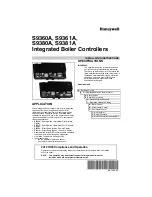
20
GAS SupplY pIpING
CHECK GAS SUPPLY
The gas pipe to your boiler must be the correct size
for the length of the run and for the total BTU per
hour input of all gas utilization equipment connected
to it. See
Natural Gas
table (following page) for the
proper size. Be sure your gas line complies with
local codes and gas company requirements.
The boiler and its individual shutoff valve must be
Confirm that installing a power venter is an option
allowed by local codes. Follow the specific power
optIoNAl hoRIZoNtAl VeNtING INStRuCtIoN
venter installation instructions issued with the
power venter kits. Although the power venter is
equipped with its own fan, the fan on the boiler
remains in place and is unaltered when a power
venter is used.
When sidewall venting, flue gases must be vented
to a point in relation to the prevailing wind so that
they may freely disperse without being blown
back at the building causing discoloration, or into
the building through doors or windows causing
odors. Also, under certain conditions flue gases
will condense, forming moisture. In such cases,
steps should be taken to prevent building materials
at the vent terminal from being damaged by the
exhausted flue gas.
When installing single wall galvanized vent
pipe for power venting follow the specific power
venter installation instructions for layout, location
of the barometric draft control and termination
connections.
When joining and sealing the single wall galvanized
or Type B vent piping, use RTV silicone sealant
with a minimum temperature rating of 400°F.
For 3” vent pipe runs, begin with the female end
of the vent pipe over the boiler’s induced draft
blower outlet. For 4” vent pipe runs begin with the
galvanized 3” to 4” increaser fitting (included in the
boiler’s parts bag) over the induced draft blower
outlet. Then follow by placing the female end of
the 4” vent pipe over the increaser fitting.
When joining pieces of single wall galvanized vent
pipe, a substantial bead of silicone should be used
at the joint to insure a leakproof connection.
Horizontal venting with a power venter is an
alternate method of sidewall venting. This boiler
is CSA listed for sidewall venting with standard
single wall galvanized or Type B vent pipe when
using the following power venter kits, which were
specifically sized for these boilers:
Number of
Field Controls
Boiler Sections Kit
Power Venter
2, 3, 4, 5
SWG-4D
6, 7
SWG-5D
Some possible reasons for using a power venter
for sidewall venting:
1. May be preferred by local codes.
2. Need a vent piping run beyond 30’ (but not
more than 50’).
3. The boiler installation site experiences gusting or
high winds. A power venter can help prevent the
boiler from short cycling due to gusting or high
winds by providing vent exhaust pressures greater
than the boiler’s induced draft blower alone.
4. When installers or homeowners prefer a
negative pressure vent system instead of a
positive pressure vent system.
5. May be more cost effective than stainless steel
venting, particularly at longer vent lengths.
The Field Controls power vent kit includes either
a SWG-II-4HD or SWG-II-5 power venter, a
MG-1 4” barometric draft controller, and the
CK-43D controls
kit.
disconnected from the gas supply piping system
during any pressure testing of that system at test
pressures in excess of ½ psig (3.5 kPa).
The boiler must be isolated from the gas supply
piping system by closing its individual manual
shutoff valve during any pressure testing of the
gas supply piping system at test pressures equal
to or less than ½ psig (3.5 kPa).
Summary of Contents for XEB-2
Page 36: ...85 Middle Rd Dunkirk NY 14048 ...
















































